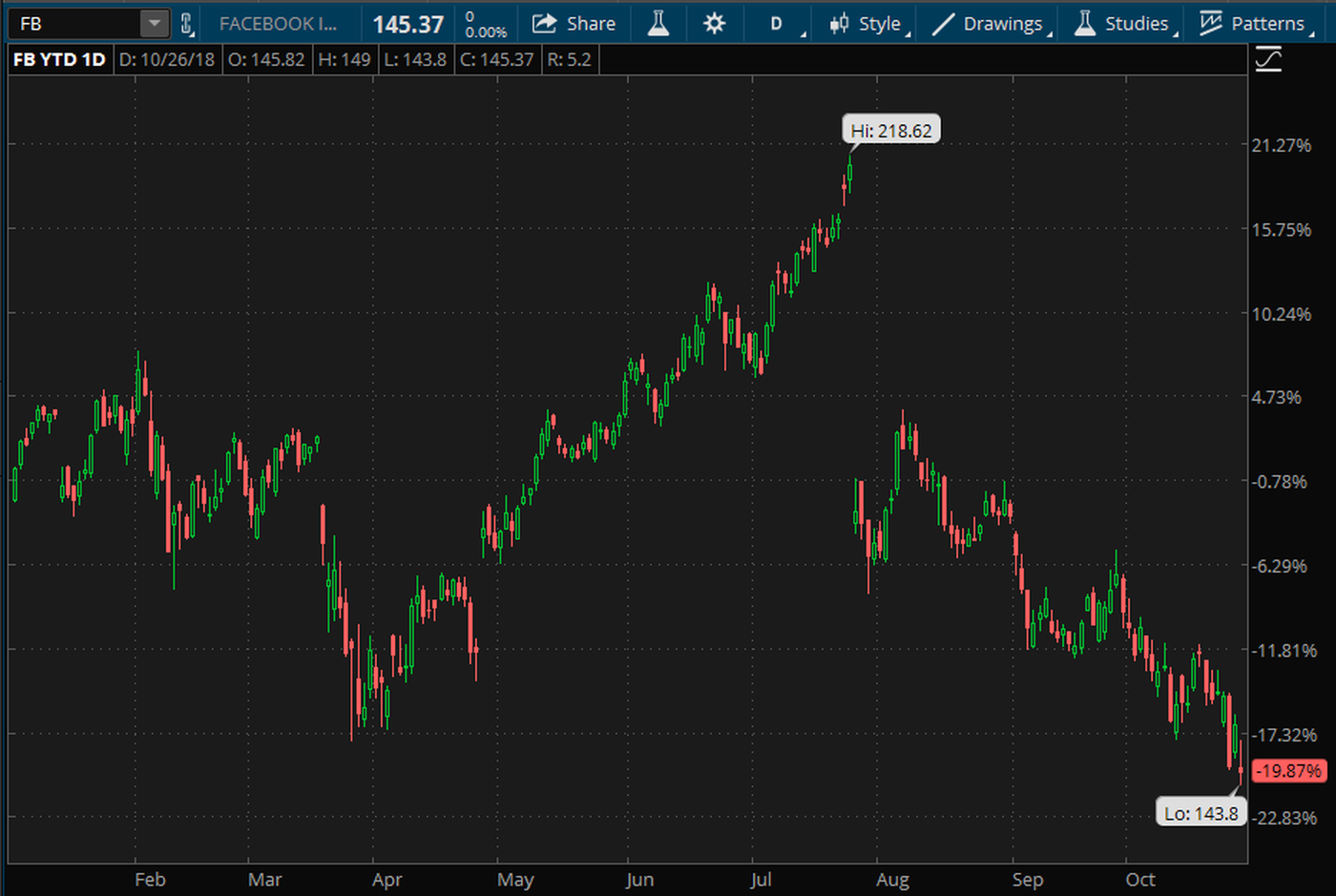It’s been a tough stretch for Facebook, Inc. (NASDAQ: FB) since it reported earnings at the end of July. In that time, the stock went from
an all-time high of $218.62 to $143.80, flipping from a 20 percent year-to-date return to about a 20 percent decline.
FB’s next earnings report is coming up after market close on Tuesday, Oct. 30. One area that analysts and investors are
likely bracing for is a deceleration in the company’s revenue growth rate, which CFO David Wehner said would continue to happen in
the second half of the year, after it slowed by 7 percent in Q2.
For Q3, FB is expected to report adjusted EPS of $1.47, down from $1.59 in the prior-year period, on revenue of $13.78 billion.
Revenue is projected to increase 33.4 percent year over year, per analysts’ estimates, slowing from the 42 percent growth the
company reported in Q2.
Advertising and Platforms
Advertising is far and away FB’s largest business. In Q2, it reported ad revenue of $13 billion out of $13.2 billion in total
revenue. Mobile ad revenue has been the driver of growth for some time and accounted for $11.9 billion of total ad revenue. The
average price per ad was up 17 percent in Q2 and ad impressions increased 21 percent, according to the company.
In recent quarters, the company has taken steps to expand ad offerings across its platform. COO Sheryl Sandberg said FB was
“making it easier to run ads on Instagram and in Stories” on last quarter’s call, and highlighted the addition of shopping features
to Instagram.
From a user perspective, FB reported having 2.23 billion monthly active users (MAUs) at the end of Q2, while daily active users
averaged 1.47 billion in June. Analyst consensus is expecting 2.29 billion MAUs for Q2.
Privacy and Security
Privacy and security concerns are likely to come up on tomorrow’s earnings call. On September 28, FB provided additional details
about a new security issue that affected 50 million accounts, after the company has already had several other incidents this year.
CEO Mark Zuckerberg and other top executives have been appearing before Congress with greater frequency this year, to provide
details about their business, these events, and how they’re responding to them.
The concerns that analysts have about these security breaches, and the scrutiny that it brings, are twofold. First, analysts are
often concerned user growth could be impacted by people that choose to delete their account, or by people who choose to not sign
up. The second concern is that advertisers could decide to spend less on that platform, or they could decide to not advertise at
all.
Wave of Departures
Several high-profile executives, including Instagram co-founders Kevin Systrom and Mike Krieger, as well as Oculus co-founder
Brendan Iribe, have departed FB recently. FB already announced that Instagram would be headed by Adam Mosseri, a long-time Facebook
executive, but several analysts have expressed concerns about the string of departures so they might be looking for some clarity
around the transition of responsibilities to new managers.
Most would probably argue Oculus is much less important than Instagram. Sales of the virtual-reality hardware is lumped into
payments and other fees, which generated $193 million in Q2 2018.

Stuck in a Downtrend? FB has been trending downward since its last earnings report. Shares closed at $145.37 on
Friday and are sitting at the $145 level, which has been a level of support since mid-2017. Chart source: thinkorswim® by TD Ameritrade. Not a recommendation. For illustrative
purposes only. Past performance does not guarantee future results.
Facebook Options Activity
Around FB’s upcoming earnings release, options traders have priced in a 7.3 percent stock move in either direction, according to
the Market Maker Move indicator on the thinkorswim® platform. Implied volatility was at
the 100th percentile as of this morning.
In short-term options trading at the Nov. 2 weekly expiration, there has been a lot of activity across a range of strikes on the
call side, with heavier volumes between the 150 and 160 strikes. On the put side, trading has been all over the place and there
haven’t been any strikes where trading has stood out.
Looking at the Nov. 16 monthly expiration coming up in a few weeks, calls have been active at the 150 and 155 strike prices,
while puts have been concentrated at the 140 and 145 strikes. There is also a sizable amount of open interest on the put side at
the 155 and 160 strikes, both of which had over 30,000 contracts open at Monday’s open.
Note: Call options represent the right, but not the obligation, to buy the underlying security at a predetermined price over
a set period of time. Put options represent the right, but not the obligation to sell the underlying security at a
predetermined price over a set period of time.
Information from TDA is not intended to be investment advice or construed as a recommendation or endorsement of any
particular investment or investment strategy, and is for illustrative purposes only. Be sure to understand all risks involved with
each strategy, including commission costs, before attempting to place any trade.
© 2018 Benzinga.com. Benzinga does not provide investment advice. All rights reserved.